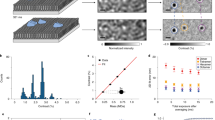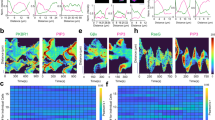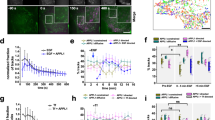Abstract
Advanced single-molecule fluorescent imaging was applied to study the dynamic organization of raft-associated glycosylphosphatidylinositol-anchored proteins (GPI-APs) in the plasma membrane and their stimulation-induced changes. In resting cells, virtually all of the GPI-APs are mobile and continually form transient (∼200 ms) homodimers (termed homodimer rafts) through ectodomain protein interactions, stabilized by the presence of the GPI-anchoring chain and cholesterol. Heterodimers do not form, suggesting a fundamental role for the specific ectodomain protein interaction. Under higher physiological expression conditions , homodimers coalesce to form hetero– and homo–GPI-AP oligomer rafts through raft-based lipid interactions. When CD59 was ligated, it formed stable oligomer rafts containing up to four CD59 molecules, which triggered intracellular Ca2+ responses that were dependent on GPI anchorage and cholesterol, suggesting a key part played by transient homodimer rafts. Transient homodimer rafts are most likely one of the basic units for the organization and function of raft domains containing GPI-APs.
This is a preview of subscription content, access via your institution
Access options
Subscribe to this journal
Receive 12 print issues and online access
$259.00 per year
only $21.58 per issue
Buy this article
- Purchase on Springer Link
- Instant access to full article PDF
Prices may be subject to local taxes which are calculated during checkout







Similar content being viewed by others
References
Simons, K. & Toomre, D. Lipid rafts and signal transduction. Nat. Rev. Mol. Cell Biol. 1, 31–39 (2000).
Chung, I. et al. Spatial control of EGF receptor activation by reversible dimerization on living cells. Nature 464, 783–787 (2010).
Lillemeier, B.F. et al. TCR and Lat expressed on separate protein islands on T cell membranes and concatenate during activation. Nat. Immunol. 11, 90–96 (2010).
Williamson, D.J. et al. Pre-existing clusters of the adaptor Lat do not participate in early T cell signaling events. Nat. Immunol. 12, 655–662 (2011).
Tavano, R. et al. CD28 interaction with filamin-A controls lipid raft accumulation at the T-cell immunological synapse. Nat. Cell Biol. 8, 1270–1276 (2006).
Sohn, H.W., Tolar, P. & Pierce, S.K. Membrane heterogeneities in the formation of B cell receptor-Lyn kinase microclusters and the immune synapse. J. Cell Biol. 182, 367–379 (2008).
Harder, T., Scheiffele, P., Verkade, P. & Simons, K. Lipid domain structure of the plasma membrane revealed by patching of membrane components. J. Cell Biol. 141, 929–942 (1998).
Chen, Y., Thelin, W.R., Yang, B., Milgram, S.L. & Jacobson, K. Transient anchorage of cross-linked glycosylphosphatidylinositol-anchored proteins depends on cholesterol, Src family kinases, caveolin, and phosphoinositides. J. Cell Biol. 175, 169–178 (2006).
Simons, K. & Gerl, M.J. Revitalizing membrane rafts: new tools and insights. Nat. Rev. Mol. Cell Biol. 11, 688–699 (2010).
Stefanová, I., Horejsi, V., Ansotegui, I.J., Knapp, W. & Stockinger, H. GPI-anchored cell-surface molecules complexed to protein tyrosine kinases. Science 254, 1016–1019 (1991).
Suzuki, K.G.N., Fujiwara, T.K., Edidin, M. & Kusumi, A. Dynamic recruitment of phospholipase Cγ at transiently immobilized GPI-anchored receptor clusters induces IP3-Ca2+ signaling: single-molecule tracking study 2. J. Cell Biol. 177, 731–742 (2007a).
Suzuki, K.G.N. et al. GPI-anchored receptor clusters transiently recruit Lyn and Gα for temporary cluster immobilization and Lyn activation: single-molecule tracking study 1. J. Cell Biol. 177, 717–730 (2007b).
Field, K.A., Holowka, D. & Baird, B. Compartmentalized activation of the high affinity immunoglobulin E receptor within membrane domains. J. Biol. Chem. 272, 4276–4280 (1997).
Kusumi, A., Koyama-Honda, I. & Suzuki, K. Molecular dynamics and interactions for creation of stimulation-induced stabilized rafts from small unstable steady-state rafts. Traffic 5, 213–230 (2004).
Lingwood, D., Ries, J., Schwille, P. & Simons, K. Plasma membranes are poised for activation of raft phase coalescence at physiological temperature. Proc. Natl. Acad. Sci. USA 105, 10005–10010 (2008).
Wu, M., Holowka, D., Craighead, H.G. & Baird, B. Visualization of plasma membrane compartmentalization with patterned lipid bilayers. Proc. Natl. Acad. Sci. USA 101, 13798–13803 (2004).
Eggeling, C. et al. Direct observation of the nanoscale dynamics of membrane lipids in a living cell. Nature 457, 1159–1162 (2009).
Lenne, P.F. et al. Dynamic molecular confinement in the plasma membrane by microdomains and the cytoskeleton meshwork. EMBO J. 25, 3245–3256 (2006).
Lasserre, R. et al. Raft nanodomains contribute to Akt/PKB plasma membrane recruitment and activation. Nat. Chem. Biol. 4, 538–547 (2008).
Plowman, S.J., Muncke, C., Parton, R.G. & Hancock, J.F. H-ras, K-ras, and plasma membrane raft proteins operate in nanoclusters with differential dependence on actin cytoskeleton. Proc. Natl. Acad. Sci. USA 102, 15500–15505 (2005).
Sahl, S.J., Leutenegger, M., Hilbert, M., Hell, S.W. & Eggeling, C. Fast molecular tracking maps nanoscale dynamics of plasma membrane lipids. Proc. Natl. Acad. Sci. USA 107, 6829–6834 (2010).
van Zanten, T.S. et al. F. Hotspots of GPI-anchored proteins and integrin nanoclusters function as nucleation sites for cell adhesion. Proc. Natl. Acad. Sci. USA 106, 18557–18562 (2009).
Koyama-Honda, I. et al. Fluorescence imaging for monitoring the colocalization of two single molecules in living cells. Biophys. J. 88, 2126–2136 (2005).
Kasai, R.S. et al. A. Full characterization of GPCR monomer-dimer dynamic equilibrium by single molecule imaging. J. Cell Biol. 192, 463–480 (2011).
Rivier, A.S. et al. Exit of GPI-anchored proteins from the ER differs in yeast and mammalian cells. Traffic 11, 1017–1033 (2010).
Dunne, P.D. et al. DySCo: quantitating associations of membrane proteins using two-color single-molecule tracking. Biophys. J. 97, L5–L7 (2009).
Keuning, S., Janssen, D.B. & Witholt, B. Purification and characterization of hydrolytic haloalkane dehalogenase from Xanthobactor autotrophicus GJ10. J. Bacteriol. 163, 635–639 (1985).
Rock, C.O. & Cronan, J.E. Jr. Re-evaluation of the solution structure of acyl carrier protein. J. Biol. Chem. 254, 9778–9785 (1979).
Goswami, D. et al. Nanoclusters of GPI-anchored proteins are formed by cortical actin-driven activity. Cell 135, 1085–1097 (2008).
Kwik, J. et al. Membrane cholesterol, lateral mobility, and the phosphatidylinositol 4,5-bisphosphate-dependent organization of cell actin. Proc. Natl. Acad. Sci. USA 100, 13964–13969 (2003).
Omidvar, N. et al. Expression of glycophosphatidylinositol-acnhored CD59 on target cells enhances human NK cell–mediated cytotoxicity. J. Immunol. 176, 2915–2923 (2006).
Rudd, P.M. et al. The glycosylation of the complement regulatory protein, human erythrocyte CD59. J. Biol. Chem. 272, 7229–7244 (1997).
Catino, M.A., Paladino, S., Tivodar, S., Pocard, T. & Zurzolo, C. N- and O-glycans are not directly involved in the oligomerization and apical sorting of GPI proteins. Traffic 9, 2141–2150 (2008).
Brameshuber, M. et al. Imaging of mobile long-lived nanoplatforms in the live cell plasma membrane. J. Biol. Chem. 285, 41765–41771 (2010).
Hu, C.D., Chinenov, Y. & Kerppola, T.K. Visualization of interactions among βZIP and Rel family proteins in living cells using bimolecular fluorescence complementation. Mol. Cell 9, 789–798 (2002).
Friedrichson, T. & Kurzchalia, T.V. Microdomains of GPI-anchored proteins in living cells revealed by crosslinking. Nature 394, 802–805 (1998).
Paladino, S. et al. Protein oligomerization modulates raft partitioning and apical sorting of GPI-anchored proteins. J. Cell Biol. 167, 699–709 (2004).
Yang, F., Moss, G. & Philips, G.N. Jr. The molecular structure of green fluorescent protein. Nat. Biotechnol. 14, 1246–1251 (1996).
Zacharias, D.A., Violin, J.D., Newton, A.C. & Tsien, R.Y. Partitioning of lipid-modified monomeric GFP into membrane microdomains of live cells. Science 296, 913–916 (2002).
Meyer, B.H. et al. FRET imaging reveals that functional neurokinin-1 receptors are monomeric and reside in membrane microdomains of live cells. Proc. Natl. Acad. Sci. USA 103, 2138–2143 (2006).
Huang, Y., Fedarovich, A., Tomlinson, S. & Davies, C. Crystal structure of CD59: implications for molecular recognition of the complement proteins C8 and C9 in the membrane-attack complex. Acta Crystallogr. D Biol. Crystallogr. 63, 714–721 (2007).
Lingwood, D. et al. Cholesterol modulates glycolipid conformation and receptor activity. Nat. Chem. Biol. 7, 260–262 (2011).
Sharma, P. et al. Nanoscale organization of multiple GPI-anchored proteins in living cell membranes. Cell 116, 577–589 (2004).
Fujita, A. et al. Gangliosides GM1 and GM3 in the living cell membrane from clusters susceptible to cholesterol depletion and chilling. Mol. Biol. Cell 18, 2112–2122 (2007).
Lommerse, P.H. et al. Single-molecule diffusion reveals similar mobility for the Lck, H-ras, and K-ras membrane anchors. Biophys. J. 91, 1090–1097 (2006).
Douglass, A.D. & Vale, R.D. Single-molecule microscopy reveals plasma membrane microdomains created by protein-protein networks that exclude or trap signaling molecules in T cells. Cell 121, 937–950 (2005).
Yokosuka, T. & Saito, T. Dynamic regulation of T-cell costimulation through TCR-CD28 microclusters. Immunol. Rev. 229, 27–40 (2009).
Gaus, K., Chklovskaia, E., Fazekas de St. Groth, B., Jessup, W. & Harder, T. Condensation of the plasma membrane at the site of T lymphocyte activation. J. Cell Biol. 171, 121–131 (2005).
De Nardo, C. et al. Recombinant transmembrane CD59 (CD59TM) confers complement resistance to GPI-anchored protein defective melanoma cells. J. Cell. Physiol. 190, 200–206 (2002).
Keller, P., Toomre, D., Diaz, E., White, J. & Simons, K. Multicolour imaging of post-Golgi sorting and trafficking in live cells. Nat. Cell Biol. 3, 140–149 (2001).
Acknowledgements
We thank V. Horejsi (Institute of Molecular Genetics, Academy of Sciences of the Czech Republic), M. Tone (University of Oxford) and M. Maio (Istituto Nazionale di Ricovero e Cura a Carattere Scientifico) for the hybridoma lines that produce the CD59- and DAF-specific antibodies, the cDNA construct for human CD59, and that for CD59TM, respectively. This work was supported in part by Grants-in-Aid for Scientific Research (A12020366) and Specific Research on Innovative Areas (23110002, 233306) from the Ministry of Education, Culture, Sports, Science and Technology of the Japanese government and by the Development of Systems and Technology for Advanced Measurement and Analysis program of the Japan Science and Technology Agency (10101506).
Author information
Authors and Affiliations
Contributions
K.G.N.S. performed experiments. T.K.F. and A.K. developed the TIRF microscope system. Y.M. developed the pOsTet15T3 vector. K.M.H., Y.L.N. and M.I. helped the data analysis. K.G.N.S., R.S.K. and A.K. formulated the project. K.G.N.S. and A.K. wrote the manuscript.
Corresponding author
Ethics declarations
Competing interests
The authors declare no competing financial interests.
Supplementary information
Supplementary Text and Figures
Supplementary Methods and Supplementary Results (PDF 11291 kb)
Supplementary Movie 1
NCHEMB-A111107315C-SupplementaryMovie1.avi (AVI 3455 kb)
Supplementary Movie 2
NCHEMB-A111107315C-SupplementaryMovie2.avi (AVI 11039 kb)
Supplementary Movie 3
NCHEMB-A111107315C-SupplementaryMovie3.avi (AVI 7869 kb)
Supplementary Movie 4
NCHEMB-A111107315C-SupplementaryMovie4.avi (AVI 5605 kb)
Supplementary Movie 5
NCHEMB-A111107315C-SupplementaryMovie5.avi (AVI 7211 kb)
Rights and permissions
About this article
Cite this article
Suzuki, K., Kasai, R., Hirosawa, K. et al. Transient GPI-anchored protein homodimers are units for raft organization and function. Nat Chem Biol 8, 774–783 (2012). https://doi.org/10.1038/nchembio.1028
Received:
Accepted:
Published:
Issue Date:
DOI: https://doi.org/10.1038/nchembio.1028
This article is cited by
-
Is cholesterol both the lock and key to abnormal transmembrane signals in Autism Spectrum Disorder?
Lipids in Health and Disease (2024)
-
Recently developed glycosphingolipid probes and their dynamic behavior in cell plasma membranes as revealed by single-molecule imaging
Glycoconjugate Journal (2023)
-
Fluorescent GD2 analog for single-molecule imaging
Glycoconjugate Journal (2023)
-
Crystal structure and cellular functions of uPAR dimer
Nature Communications (2022)
-
Single-molecule FRET imaging of GPCR dimers in living cells
Nature Methods (2021)



